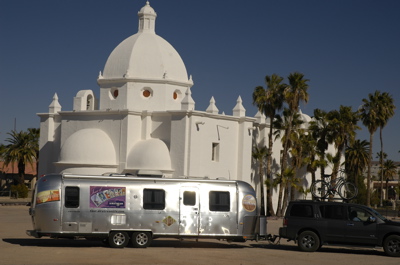All along I-8 through southern California, the nearness of Mexico is readily apparent. It lurks across the border, sometimes only a few hundred feet away, sometimes a few miles. We have seen dozens of Border Patrol vehicles along the roadside, and we have passed through checkpoints along lonely roads near Anza Borrego, Yuma, and Organ Pipe Cactus National Monument.
From I-8 you turn south at Gila Bend, a tiny desert town that one might think would forever be a speck on the desert. A great place to “eat food, get gas” before heading somewhere else. But even Gila Bend is starting to feel the impact of Phoenix’s burgeoning suburbs 50 miles away ““ the newspaper is printing optimistic articles about how locals stand to get rich quick selling desert tracts to Phoenix commuters.

We stopped in the town of Ajo along Rt 85, expecting that it would be yet another dying desert town of the southwest. Ajo is a relic of copper mining, a town left over when the giant open-pit mine was shut down in 1985. But this little town is a surprise. It is still alive, with families enough to fill a small high school, a marvelous Spanish Colonial Revival-style plaza in the center, and a historic district filled with tiny copper miners’ bungalow homes. There is a historical museum, a downtown filled with shops, three real estate agencies, and several beautiful whitewashed stucco churches in the Mission style.
Ajo is a landlocked town, destined never to grow. It is surrounded by Air Force testing range to the north, the Cabeza Prieta National Wildlife Reserve to the east, the Tohono O’odham (Native American) Nation to the east, and Organ Pipe Cactus National Monument to the south. It’s the perfect place for someone who wants to become a desert rat, retire cheap, or who wants to live free of the pressure of rising real estate costs and sprawl. You can buy a fixer-upper for $40,000 and live in the endless sunshine and wide-open space.
The Mexican influence is apparent here, too, with “Mexican Insurance” signs all along the highway strip in Ajo, and a strong Mexican population living alongside the Border Patrol officers and Sheriff’s Department officers who make up a large portion of Ajo’s community today. Since 2001, the general beefing-up of the border has resulted in a swell of law enforcement in border towns, and Ajo is the nearest town to the crossing at Lukeville.
From the campground in Organ Pipe Cactus National Monument, we can see the lights of Mexico at night, but they are mostly from cars in the tiny border town of Sonoyta, six miles away. There’s not much on the southern side until you get to Puerto Peñasco (Rocky Point) on the Gulf of California, 60 miles away. The volunteers here in the park organize a weekly market run to get food there, which explains why the presenter at last night’s amphitheater show had fresh shrimp for dinner, here in the middle of the desert.
I was tempted to suggest we go over the border too, just for a look-see, but the nearest spot to get Mexican insurance is back in Why, 26 miles north. There’s too much to do right here in the Monument to justify spending that amount of time in the car today. We will only be here two nights before we head to Patagonia.
Our batteries are dead this morning. We boondocked in a Yuma parking lot on Friday night, and there’s no electric in this campground, so Saturday night was a second night without plugging in. Overnight temperatures here in the clear desert nights have been in the 40s. With the furnace running both nights, the batteries have been drained to a bare minimum. The refrigerator’s control board is still working, but the propane detector gave up this morning, and the water pump is pretty much not pumping anymore.
It’s clear that the trailer does not recharge well from the truck. I believe that the voltage output from the truck is not ideal for re-charging batteries. So even though we towed for three hours yesterday it didn’t do much. Even still, the generator would have saved us, but this park has unusual generator hours: noon to 4 pm. We arrived at 3:40 pm.
There’s nothing for it but to wait until noon and run the generator for the full four hours we are allowed. I’m glad we have a moderately quiet Honda eu1000i, but still I’d rather have solar. This is at least the third time we’ve been caught low on power, waiting for generator hours to get charged back up. Eleanor and I have become convinced that for full-timers who want to visit National Parks (which often do not have electric sites), there is no substitute for solar panels and a good-sized battery bank.

